人教版初中七年级上册英语说课稿
- 格式:doc
- 大小:300.50 KB
- 文档页数:103
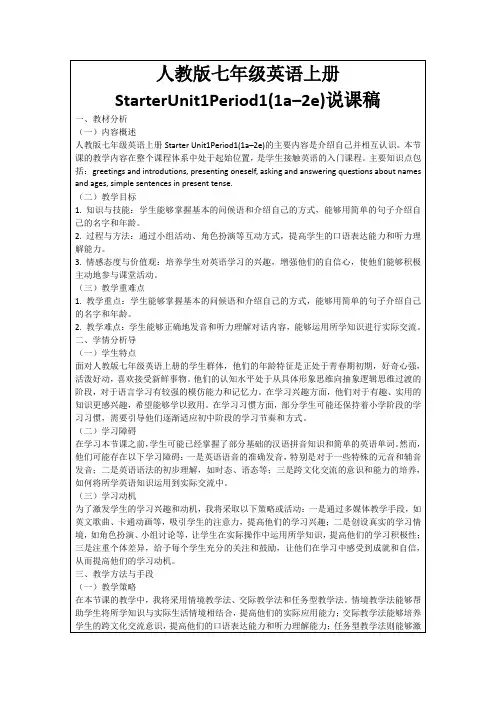
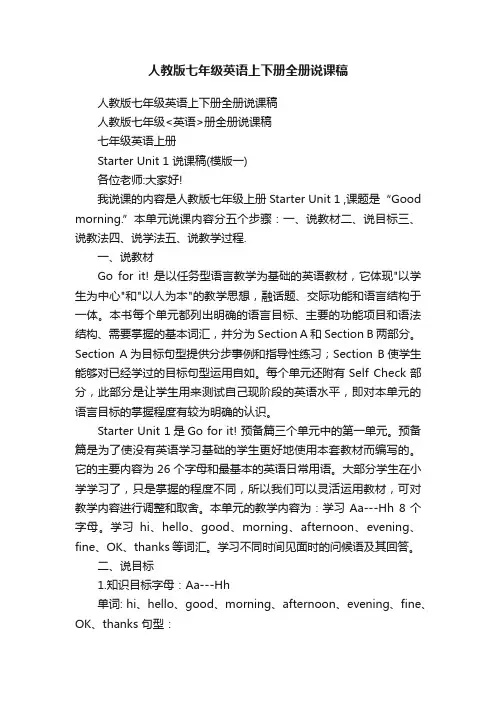
人教版七年级英语上下册全册说课稿人教版七年级英语上下册全册说课稿人教版七年级<英语>册全册说课稿七年级英语上册Starter Unit 1 说课稿(模版一)各位老师:大家好!我说课的内容是人教版七年级上册Starter Unit 1 ,课题是“Good morning.”本单元说课内容分五个步骤:一、说教材二、说目标三、说教法四、说学法五、说教学过程.一、说教材Go for it! 是以任务型语言教学为基础的英语教材,它体现"以学生为中心"和"以人为本"的教学思想,融话题、交际功能和语言结构于一体。
本书每个单元都列出明确的语言目标、主要的功能项目和语法结构、需要掌握的基本词汇,并分为Section A和Section B两部分。
Section A为目标句型提供分步事例和指导性练习;Section B使学生能够对已经学过的目标句型运用自如。
每个单元还附有Self Check部分,此部分是让学生用来测试自己现阶段的英语水平,即对本单元的语言目标的掌握程度有较为明确的认识。
Starter Unit 1是Go for it! 预备篇三个单元中的第一单元。
预备篇是为了使没有英语学习基础的学生更好地使用本套教材而编写的。
它的主要内容为26个字母和最基本的英语日常用语。
大部分学生在小学学习了,只是掌握的程度不同,所以我们可以灵活运用教材,可对教学内容进行调整和取舍。
本单元的教学内容为:学习Aa---Hh 8个字母。
学习hi、hello、good、morning、afternoon、evening、fine、OK、thanks等词汇。
学习不同时间见面时的问候语及其回答。
二、说目标1.知识目标字母:Aa---Hh单词: hi、hello、good、morning、afternoon、evening、fine、OK、thanks 句型:1).--Good morning, Alice! ---Good morning !2).--Hello, Frank!--Hi, Cindy! How are you? --I'm fine/OK, thanks.2. 能力目标训练学生听、说、读、写的能力。

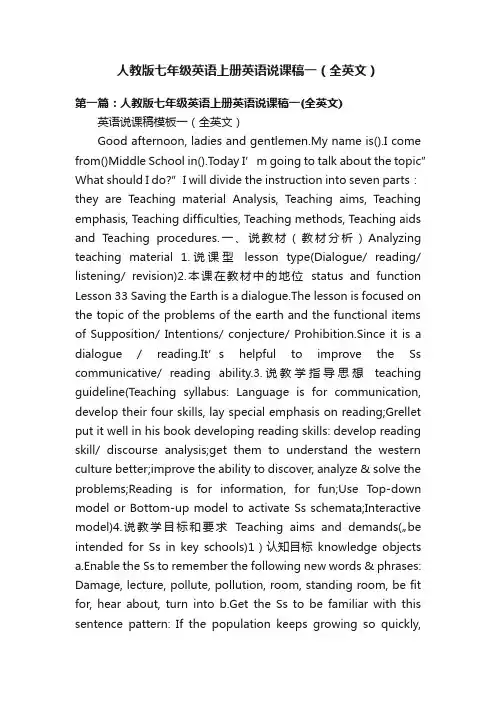
人教版七年级英语上册英语说课稿一(全英文)第一篇:人教版七年级英语上册英语说课稿一(全英文)英语说课稿模板一(全英文)Good afternoon, ladies and gentlemen.My name is().I come from()Middle School in().T oday I’m going to talk about the topic” What should I do?”I will divide the instruction into seven parts:they are Teaching material Analysis, Teaching aims, Teaching emphasis, Teaching difficulties, Teaching methods, Teaching aids and Teaching procedures.一、说教材(教材分析)Analyzing teaching material 1.说课型lesson type(Dialogue/ reading/ listening/ revision)2.本课在教材中的地位status and function Lesson 33 Saving the Earth is a dialogue.The lesson is focused on the topic of the problems of the earth and the functional items of Supposition/ Intentions/ conjecture/ Prohibition.Since it is a dialogue / reading.It’s helpful to improve the Ss communicative/ reading ability.3.说教学指导思想teaching guideline(Teaching syllabus: Language is for communication, develop their four skills, lay special emphasis on reading;Grellet put it well in his book developing reading skills: develop reading skill/ discourse analysis;get them to understand the western culture better;improve the ability to discover, analyze & solve the problems;Reading is for information, for fun;Use T op-down model or Bottom-up model to activate Ss schemata;Interactive model)4.说教学目标和要求Teaching aims and demands(…be intended for Ss in key schools)1)认知目标knowledge objects a.Enable the Ss to remember the following new words & phrases: Damage, lecture, pollute, pollution, room, standing room, be fit for, hear about, turn into b.Get the Ss to be familiar with this sentence pattern: If the population keeps growing so quickly,there will only be standing room left… Give the Ss a reinforced practice on the functional item Supposition.c.Activate Ss schemata regarding the topic of pollution and help Ss to know more about the problem of pollution.2)智能目标 ability objects a.Ask the Ss to make up a similar dialogue.b.Help them to understand the dialogue better and improve the four skills.c.Develop their ability of thinking independently.d.Cultivate their ability to discover, analyze and solve problems.e.Train them to collect information from the Internet.f.Train them with some effective learning methods to optimize Ss’ learning res ults.3)德育目标moral objects a.Arouse their interest in learning English;b.Help them to understand the background of pollution.c.Enable the students to love our earth and the nature.d.Be aware of the importance of stopping pollution & protecting out environment.e.Encourage the Ss to do something to save the earth.5.说教学重点 teaching important points(生词、句型;培养阅读技能)a.New words and phrases b.Sentence pattern: If-clause c.improve their reading skills.d.Talking about problems of the Earth.6.说教学难点 teaching difficult points(语法;发展交际能力)a.functional item: Supposition.b.Develop their communicative ability.Act out their own dialogue.7.说教具teaching aids(multi-media computer, software, OHP)The teaching syllabus says that it’s necessary for teachers to use modern teaching facilit ies.It’s of great help to increase the class density and improve our teaching result.It can also make the Ss reach a better understanding of the text by making the classes lively and interesting.At the same time, it arouses the Ss’ interest in learning English.二、说教法T eaching methods Five step method;audio-video;communicative approach;Task-based learning: New Syllabus Design encourages teachers to use thisteaching method.TBLT can stimulate Ss’ initiative in learning and develop their ability in language application.Make the Ss the real masters in class while the teacher himself acts as the director and bring their ability into full play.三、说学法Study methods 1.Teach Ss how to be successful language learners.2.Teach Ss how to develop the reading skill — skim & scan;how to communicate with others;how to learn new words;how to learn independently;3.Get the Ss to form good learning habits.四、说教学过程Teaching procedures I.复习(Revision)5min(Daily report;词汇diagram;brainstorming;activate schemata)Activity 1: Imagination 1).Suppose a bottle of ink is turned over and dirties your white shirt, what is to be done?(Wash it? Or throw it away?)2).Suppose you catch a bad cold, what’s to be done?3).Suppose your bike is broken, what’s to be done?4).And suppose the earth, on which we all live, is damaged, what’s to be done? * What can you think of when you see “pollution” this word?(waste, environment, air, water, factory, desert, climate...Try to activate the Ss schemata regarding the topic of pollution.)II.呈现(Presentation)5min Activity 2: Presentation Play the song “Earth Song” sung by Michael Jackson.(Create an atmosphere)A lot of pictures and video clips about the causes and results of the three problems mentioned in this lesson will be shown on the screen with the help of the comp uter.Ss’ presentation on pollution.Attract their attention, arouse their interest, and create a good atmosphere for communication.* Activate their schemata and cultivate their ability in collecting information from the Internet and develop their ability in thinking independently.III.对话/ 阅读(Dialogue)18m 1.Pre-reading Activity 3: Prediction 1st listening/ fast reading, one guided Q to help Ss to get the main idea: Whatdo you think is discussed at the conference? 2.While-reading Activity 4: Read and answer 2nd listening/ careful reading, more Qs to get the detailed information.Develop their reading skills: skim & scan.Pay attention to the pronunciation, stress & intonation.* 阅读: Pre-reading;while-reading;post-reading(fast reading/ careful reading;skim/ scan;识别关键词key words;确定主题句;创设信息差information gap;T or F;填表格chart/diagram;Predicting;Make a timeline;Make a story map。
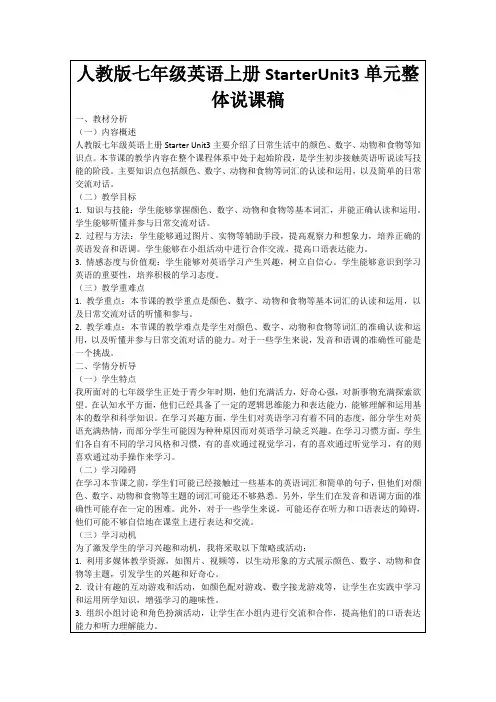
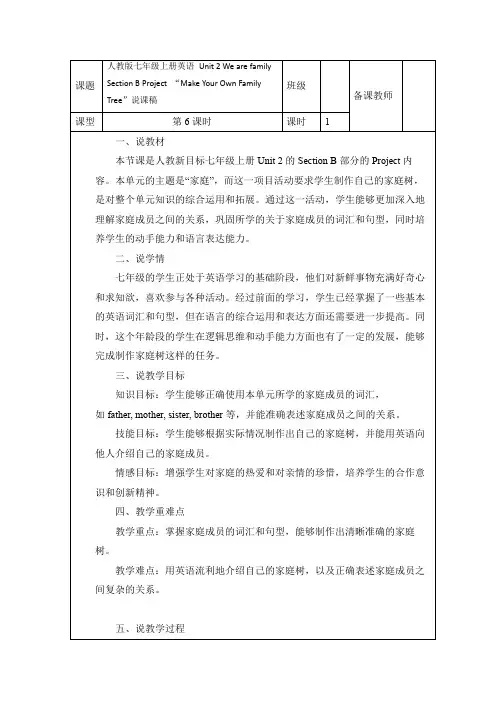
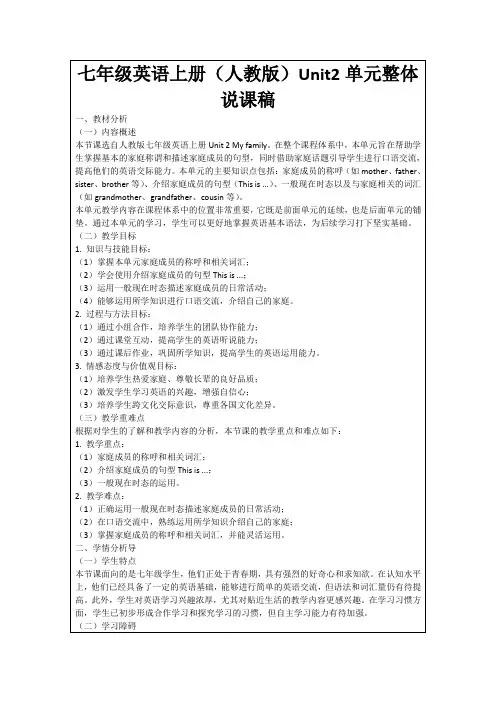
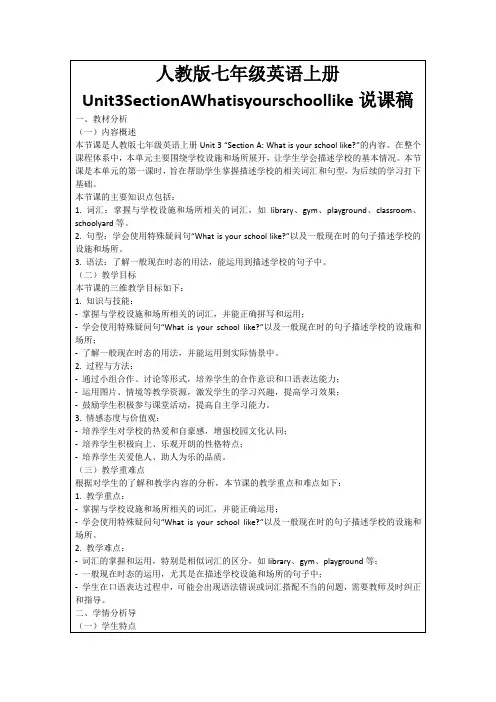
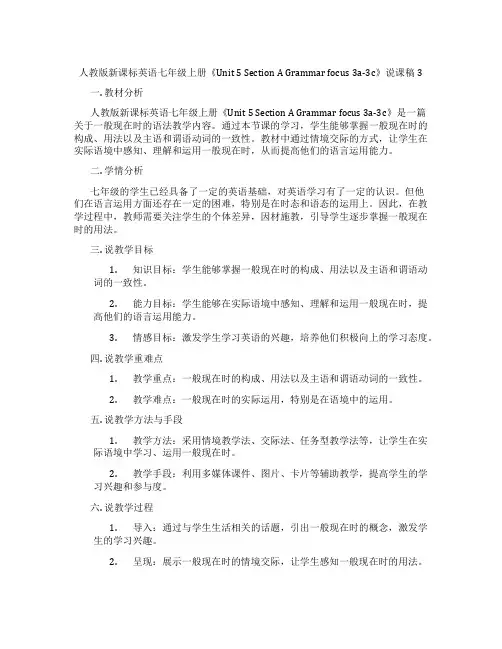
人教版新课标英语七年级上册《Unit 5 Section A Grammar focus 3a-3c》说课稿3一. 教材分析人教版新课标英语七年级上册《Unit 5 Section A Grammar focus 3a-3c》是一篇关于一般现在时的语法教学内容。
通过本节课的学习,学生能够掌握一般现在时的构成、用法以及主语和谓语动词的一致性。
教材中通过情境交际的方式,让学生在实际语境中感知、理解和运用一般现在时,从而提高他们的语言运用能力。
二. 学情分析七年级的学生已经具备了一定的英语基础,对英语学习有了一定的认识。
但他们在语言运用方面还存在一定的困难,特别是在时态和语态的运用上。
因此,在教学过程中,教师需要关注学生的个体差异,因材施教,引导学生逐步掌握一般现在时的用法。
三. 说教学目标1.知识目标:学生能够掌握一般现在时的构成、用法以及主语和谓语动词的一致性。
2.能力目标:学生能够在实际语境中感知、理解和运用一般现在时,提高他们的语言运用能力。
3.情感目标:激发学生学习英语的兴趣,培养他们积极向上的学习态度。
四. 说教学重难点1.教学重点:一般现在时的构成、用法以及主语和谓语动词的一致性。
2.教学难点:一般现在时的实际运用,特别是在语境中的运用。
五. 说教学方法与手段1.教学方法:采用情境教学法、交际法、任务型教学法等,让学生在实际语境中学习、运用一般现在时。
2.教学手段:利用多媒体课件、图片、卡片等辅助教学,提高学生的学习兴趣和参与度。
六. 说教学过程1.导入:通过与学生生活相关的话题,引出一般现在时的概念,激发学生的学习兴趣。
2.呈现:展示一般现在时的情境交际,让学生感知一般现在时的用法。
3.操练:通过小组活动、游戏等形式,让学生在实际语境中练习一般现在时的运用。
4.巩固:通过完成任务、角色扮演等活动,让学生进一步巩固一般现在时的用法。
5.拓展:引导学生运用一般现在时进行创新性表达,提高他们的语言运用能力。
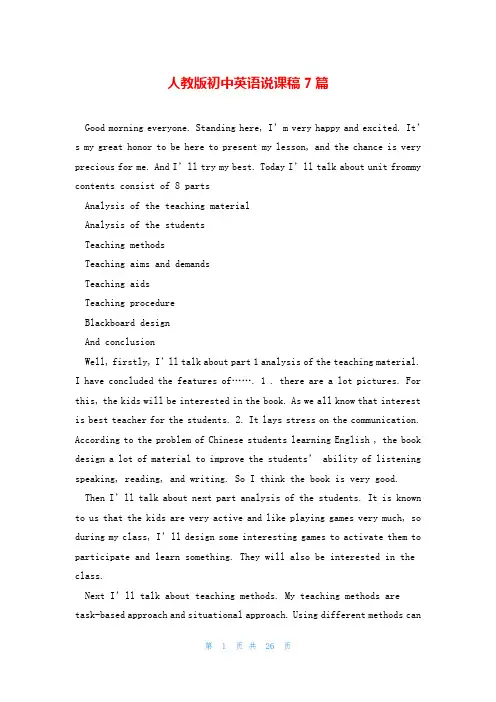
人教版初中英语说课稿7篇Good morning everyone. Standing here, I’m very happy and excited. It’s my great honor to be here to present my lesson, and the chance is very precious for me. And I’ll try my best. Today I’ll talk about unit frommy contents consist of 8 partsAnalysis of the teaching materialAnalysis of the studentsTeaching methodsTeaching aims and demandsTeaching aidsTeaching procedureBlackboard designAnd conclusionWell, firstly, I’ll talk about part 1 analysis of the teaching material.I have concluded the features of……. 1 . there are a lot pictures. For this, the kids will be interested in the book. As we all know that interest is best teacher for the students. 2. It lays stress on the communication. According to the problem of Chinese students learning English , the book design a lot of material to improve the students’ ability of listening speaking, reading, and writing. So I think the book is very good.Then I’ll talk about next part analysis of the students. It is known to us that the kids are very active and like playing games very much, so during my class, I’ll design some interesting games to activate them to participate and learn something. They will also be interested in the class.Next I’ll talk about teaching methods. My teaching methods are task-based approach and situational approach. Using different methods canmake the class active.Let’s move on to another part, teaching aims and demands. There are knowledge aims and ability aim.Knowledge aims are to enable the students to master the words and phrases:………. And the sentences:…Ability aims are To improve students’listening and speaking ability by reading and practicing the dialogue. Next is the teaching aids. In this class, I’ll use pictures, PPT and tape recorder. These can arouse the students’ interest in English. Now I’ll talk about most important part teaching procedure. It consists of 5 steps. Warning up, lead-in, contents key points and difficult points and homework.Step1 is warming up. Here I’ll use PPT to play a English song Bingo for the students and I’ll ask them try to follow it to sing together. By this, the students can be interested in it and pay their attention to our class easily and improve their ability of speaking.Step2 is lead-in (导入根据所授内容设计,可通过展示与本课有关的话题或者图片等等引出本课话题)Step 3 is contents(本部分为主要授课内容及组织的课堂活动。
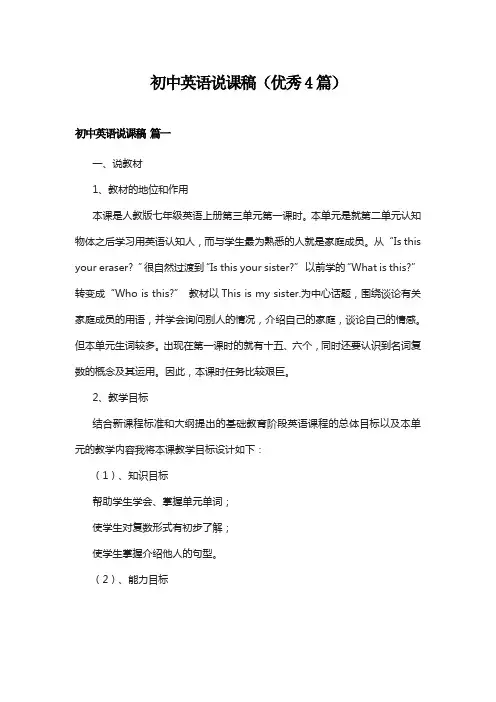
初中英语说课稿(优秀4篇)初中英语说课稿篇一一、说教材1、教材的地位和作用本课是人教版七年级英语上册第三单元第一课时。
本单元是就第二单元认知物体之后学习用英语认知人,而与学生最为熟悉的人就是家庭成员。
从“Is this your eraser? ”很自然过渡到“Is this your sister?”以前学的“What is this?”转变成“Who is this?”教材以This is my sister.为中心话题,围绕谈论有关家庭成员的用语,并学会询问别人的情况,介绍自己的家庭,谈论自己的情感。
但本单元生词较多。
出现在第一课时的就有十五、六个,同时还要认识到名词复数的概念及其运用。
因此,本课时任务比较艰巨。
2、教学目标结合新课程标准和大纲提出的基础教育阶段英语课程的总体目标以及本单元的教学内容我将本课教学目标设计如下:(1)、知识目标帮助学生学会、掌握单元单词;使学生对复数形式有初步了解;使学生掌握介绍他人的句型。
(2)、能力目标通过本节课学习,学生就家庭成员相互之间能用英语简单的介绍、询问、交流。
掌握基本This is/That is.。
. These are/Those are.。
. 等句型,培养学生实际交际的能力。
同时基本上能辨别什么时候用单数什么时候用复数。
(3)、情感目标通过介绍家人和朋友,学生对自己的家庭成员会有更清晰的印象,对学生进行亲情教育,从而激发起他们对家人的热爱。
3、教学重点及难点结合教学目标的要求和学生的特点,我把本课的重难点设置为:重点:熟练掌握各家庭成员的名称,理解外国文化中介绍家庭成员的方式。
这个单元最主要的就是学习家庭成员英语的表达,而几乎所有的单词都集中在第一课时。
所以这课时学会掌握这些单词应该是重中之重。
难点:复数的认识和正确运用。
汉语表达中完全没有复数概念,这是一本书,这是三本书;除了数字的改变没有其他任何变化。
而英语必须这样说This is a book. These are books.所有的单词都相应的发生了变化。
英语英文说课稿人教版七上英语说课稿人教版七上一、教学目标本课程的教学目标旨在通过对人教版七年级上册英语教材的深入学习,使学生达到以下几个方面的要求:1. 掌握本册教材中的基本词汇和常用句型,能够进行简单的日常交流。
2. 培养学生的英语听说能力,使学生能够在真实或模拟的情境中运用英语进行沟通。
3. 激发学生的学习兴趣,培养学生良好的学习习惯和自主学习的能力。
4. 通过英语学习,增强学生的跨文化交际意识和国际视野。
二、教学内容与分析本册教材共分为12个单元,每个单元包含两个课时。
每个单元围绕一个主题展开,通过对话、短文、练习等形式,使学生逐步掌握相关的语言知识。
1. 词汇与语法- 词汇:重点学习与日常生活相关的词汇,如家庭成员、学校科目、日常活动等。
- 语法:初步学习一般现在时、一般过去时等基本时态,以及简单句的构成。
2. 听力与口语- 听力:通过听录音、观看视频等活动,提高学生的听力理解能力。
- 口语:通过角色扮演、情景对话等活动,训练学生的口语表达能力。
3. 阅读与写作- 阅读:通过阅读短文、故事等材料,提高学生的阅读理解能力。
- 写作:初步学习写作技巧,能够书写简短的日记、信件等。
三、教学方法与策略1. 任务型教学法:通过设计贴近学生生活的任务,使学生在完成任务的过程中学习语言。
2. 合作学习:鼓励学生进行小组合作,通过交流和讨论,提高语言运用能力。
3. 情景教学法:创设真实或模拟的情景,让学生在情境中学习和使用英语。
4. 多媒体辅助教学:利用多媒体资源,如音频、视频、图片等,丰富教学内容,提高教学效果。
四、教学评价1. 形成性评价:通过课堂表现、作业完成情况、小组活动等方面,持续跟踪学生的学习进度。
2. 终结性评价:通过期末考试、口语测试等形式,综合评价学生的学习成果。
五、教学进度安排1. 第1-2周:完成单元1和单元2的教学,重点学习问候语、自我介绍等基本交流技能。
2. 第3-6周:完成单元3至单元6的教学,学习描述日常生活、谈论个人喜好等内容。
人教版中学七年级英语上册全册说课稿一. 教材分析人教版中学七年级英语上册全册说课稿的教材分析主要从教材内容、教材结构、教材目标和教材特点四个方面进行。
1.教材内容:本册教材共分为12个单元,每个单元包括课文、词汇、语法、功能项目、听力、口语、写作和文化角等部分。
教材内容丰富,涵盖了日常生活中的各种场景,旨在培养学生的综合语言运用能力。
2.教材结构:本册教材的结构清晰,每个单元的主题明确,各部分内容相互关联,形成一个有机的整体。
课文部分以故事、对话等形式呈现,词汇和语法部分分别针对本单元的主题进行讲解和练习,功能项目部分则通过实际场景的模拟,培养学生的实际应用能力。
3.教材目标:本册教材的目标是使学生掌握基础英语知识,提高听、说、读、写四项基本技能,培养学生的语言运用能力和跨文化交际能力。
4.教材特点:本册教材具有以下特点:(1)实用性:教材内容紧密结合学生的生活实际,有利于学生将英语应用于实际生活中;(2)趣味性:教材以学生感兴趣的话题为主题,采用生动、有趣的形式呈现,激发学生的学习兴趣;(3)针对性:教材针对中国学生的学习特点,进行有针对性的教学设计,提高教学效果。
二. 学情分析学情分析主要从学生的年龄特点、知识基础、学习兴趣和特点以及学习需求等方面进行。
1.学生年龄特点:七年级的学生正处于青春发育期,对新鲜事物充满好奇,具有较强的学习能力和模仿能力。
2.知识基础:大部分学生已经掌握了26个字母,对简单的单词和句子有一定的了解,但英语听说能力较差,语法知识较弱。
3.学习兴趣和特点:学生对英语学习具有一定的兴趣,但容易受到母语的影响,学习过程中容易产生挫败感。
4.学习需求:学生需要通过系统的英语学习,提高听、说、读、写四项基本技能,为今后的学习和生活打下良好的基础。
三. 说教学目标1.知识目标:使学生掌握本单元的单词、短语、句型和语法知识。
2.能力目标:提高学生的听、说、读、写四项基本技能,培养学生的语言运用能力和跨文化交际能力。
人教版七年级上册英语说课稿第一篇:人教版七年级上册英语说课稿人教版七年级上册Unit6 Do you like bananas? 说课稿各位老师、同学大家好!今天我要谈的是人教版新目标英语七年级上册Unit 6 Do you like bananas? 第一课时的教学。
一、教材分析(一)教材的地位和作用本单元学习的是与学生生活密切相关的话题食物,由Section A , Section B 和Self check三个部分组成。
本节课是第六单元的第一课时,因此主要是Section A 部分的内容。
教材内容围绕着谈论喜欢与不喜欢的食物展开,易于激发学生的学习兴趣。
本课时以听说为主,要求学生在学习活动中运用所学单词和句型进行交际,有助于培养学生的口语表达能力和综合语言运用能力。
(二)教学目标《课程标准》中说:英语教学的目的是培养学生运用语言进行交际的能力,为用而学,在用中学,学了就用。
因此我把本课的教学目标定为以下几个方面:1.知识目标1)通过对本节课的学习,学生将能够认识并掌握一些有关食物方面的单词,如hamburger, French fries, salad, strawberry, broccoli.2)能理解并正确使用以下句型:Do you like…? Yes, I do./No,I don’t.2.能力目标1)能用本课所学句型自由的谈论喜欢喝不喜欢的食物。
2)能区分可数名词和不可数名词。
3.情感目标1)在小组合作中积极参与讨论,互相帮助,团队合作意识增强。
2)能够养成健康合理的饮食习惯,学会关心父母。
(三)教学重点及难点1.教学重点:掌握各种有关食物方面的名词;实义动词like一般现在时的疑问是及其答语。
2.教学难点:如何谈论自己的喜好和厌恶;区分可数名词和不可数名词。
二、学生分析初一学生性格特点是活泼好动,爱表现,参与活动的热情会很高。
面对可塑性很强的学生,作为英语教师,我们一定要保护他们对英语学习的热情。
人教版初中英语初一英语上册《Unit》说课稿一、教材分析《Unit》是人教版初中英语初一上册的教材单元,本单元主要内容涵盖了以下几个方面:单词、词组、句型、语法、听力、口语、阅读、写作等。
通过本单元的学习,学生将能够掌握一些基础的英语词汇和句型,提高听说读写能力。
二、教学目标本单元的教学目标主要包括以下几个方面: 1. 语言知识与技能:掌握本单元中的核心词汇、词组和句型,能够正确运用它们进行日常交际。
2. 听说读技能:通过听力训练、口语操练和阅读练习,提高学生的听说读能力,培养他们的语感和阅读理解能力。
3. 跨学科能力:通过阅读和写作训练,培养学生的思维能力、表达能力和解决问题的能力。
4. 学习策略:培养学生的自主学习能力和合作学习能力,激发他们学习英语的兴趣和主动性。
三、教学重点本单元的教学重点主要集中在以下几个方面: 1. 单词和词组:掌握本单元中的重点单词和词组,包括用法和搭配。
2. 句型和语法:掌握本单元中的重点句型和相关语法知识,能够正确运用它们进行日常交际。
3. 听力和口语:通过听力训练和口语操练,提高学生的听力理解能力和口语表达能力。
四、教学内容与方法1. 教学内容本单元的教学内容主要包括以下几个方面: 1. 单词和词组:教授本单元中的核心词汇和词组,从拼读、词义、用法和搭配等方面进行讲解和练习。
2. 句型和语法:教授本单元中的常见句型和相关语法知识,如一般现在时、一般过去时等,通过分析例句和实际用法进行讲解和练习。
3. 听力和口语:通过听力材料和口语操练,提高学生的听力理解能力和口语表达能力。
2. 教学方法为了达到教学目标,我将采用以下教学方法: 1. 直观教学法:通过图片、实物和示范等方式,帮助学生理解单词、词组的意义和用法。
2. 合作学习法:通过小组合作活动,鼓励学生互相合作、讨论和交流,提高他们的口语表达能力和团队合作能力。
3. 多媒体教学法:通过播放音频和视频材料,让学生进行听力训练和模仿口语,提高他们的听说能力。
人教版七年级英语上册全册说课稿七年级英语上册目录:Starter Unit1Good morning!说课模版(一) (3)Starter Unit1Good morning!说课模版(二) (5)Starter Unit2 What’s this in English?说课模版(一) (7)Starter Unit2 What’s this in English?说课模版(二) (9)Starter Unit3What color is it? 说课模版(一) (11)Starter Unit3What color is it? 说课模版(二) (14)Unit1My name’s Gina说课模版(一) (15)Unit1My name’s Gina说课模版(二) (18)Unit2This is my sister 说课模版(一) (21)Unit2This is my sister 说课模版(二) (24)Unit3Is this your pencil? 说课模版(一) (26)Unit3Is this your pencil? 说课模版(二) (29)Unit4Where's my schoolbag? 说课模版(一) (32)Unit4Where's my schoolbag? 说课模版(二) (37)Unit5Do you have a soccer ball? 说课模版(一) (44)Unit5Do you have a soccer ball? 说课模版(二) (48)Unit6Do you like bananas? 说课模版(一) (53)Unit6Do you like bananas? 说课模版(二) (57)Unit7How much are these socks? 说课模版(一) (63)Unit7How much are these socks? 说课模版(二) (68)Unit8When is your birthday?说课模版(一) (71)Unit8When is your birthday?说课模版(二) (76)Unit9My favorite subject is science.说课模版(一) (82)Unit9My favorite subject is science.说课模版(一) (85)七年级英语上册Starter Unit 1 说课稿(模版一)各位老师:大家好!我说课的内容是人教版七年级上册Starter Unit 1 ,课题是“Good morning.”本单元说课内容分五个步骤:一、说教材二、说目标三、说教法四、说学法五、说教学过程.一、说教材Go for it! 是以任务型语言教学为基础的英语教材,它体现"以学生为中心"和"以人为本"的教学思想,融话题、交际功能和语言结构于一体。
本书每个单元都列出明确的语言目标、主要的功能项目和语法结构、需要掌握的基本词汇,并分为Section A和Section B两部分。
Section A为目标句型提供分步事例和指导性练习;Section B使学生能够对已经学过的目标句型运用自如。
每个单元还附有Self Check部分,此部分是让学生用来测试自己现阶段的英语水平,即对本单元的语言目标的掌握程度有较为明确的认识。
Starter Unit 1是Go for it! 预备篇三个单元中的第一单元。
预备篇是为了使没有英语学习基础的学生更好地使用本套教材而编写的。
它的主要内容为26个字母和最基本的英语日常用语。
大部分学生在小学学习了,只是掌握的程度不同,所以我们可以灵活运用教材,可对教学内容进行调整和取舍。
本单元的教学内容为:学习Aa---Hh 8个字母。
学习hi、hello、good、morning、afternoon、evening、fine、OK、thanks等词汇。
学习不同时间见面时的问候语及其回答。
二、说目标1.知识目标字母:Aa---Hh单词: hi、hello、good、morning、afternoon、evening、fine、OK、thanks 句型:1).--Good morning, Alice! ---Good morning !2).--Hello, Frank!--Hi, Cindy! How are you? --I'm fine/OK, thanks.2. 能力目标训练学生听、说、读、写的能力。
3. 情感目标培养学生热情大方、乐观的性格。
培养学生们对英语的兴趣。
三、说教法本单元主要是简单的日常交际语言和八个大小写字母,虽然学生在小学已学,但可能学生对此掌握的情况悬殊很大:1.情景教学法,赋予知识和技能训练以真实的情景和语境,调动学生的参与热情。
2.听说读写综合训练,培养语言运用能力。
3.在教学中创设切实可行的任务型教学活动、突出交际性。
4.采用电教设备和自制教具,增强直观性和趣味性。
四、说学法1.知识目标字母:Aa---Hh单词: hi、hello、good、morning、afternoon、evening、fine、OK、thanks 句型:1).--Good morning, Alice! ---Good morning !2).--Hello, Frank!--Hi, Cindy! How are you? --I'm fine/OK, thanks.2. 能力目标训练学生听、说、读、写的能力。
3. 情感目标培养学生热情大方、乐观的性格。
培养学生们对英语的兴趣。
三、说教法本单元主要是简单的日常交际语言和八个大小写字母,虽然学生在小学已学,但可能学生对此掌握的情况悬殊很大:1.情景教学法,赋予知识和技能训练以真实的情景和语境,调动学生的参与热情。
2.听说读写综合训练,培养语言运用能力。
3.在教学中创设切实可行的任务型教学活动、突出交际性。
4.采用电教设备和自制教具,增强直观性和趣味性。
四、说学法1、学会自学:变被动学习为主动学习,带着问题有目的地听课,可以更好地把握课堂的重点和难点,提高课堂效率。
2、在操练中学习:在情切的师生和生生口语交流中学习,这样可以大大提高学生积极参与度。
3、合作学习:划分不同小组,培养团队精神,更好地掌握本课所学知识。
五、说教学过程The first period Step 1:Warming upListen to a "Good morning!" song. Then Ss learn to sing this song.营造轻松愉悦的学习环境,激发学生参加活动的积极性。
Step 2: Showing studying aimsStep 3:Greeting & IntroductionStep 4:While-taskTask1: Greeting people & learning English name此活动对大部分学生没困难,主要是学生是否敢开口,因此活动目的是培养学生大胆,自然的口语交际能力,在活动中让他们感受到会使用英语的成就感,从而激发学习英语的热情。
1.Finsh 1a with your partner.2.Choose an Enlish name for yourself.3.Teach Ss to read English name. Ss repeat after the teache r one by one until they know everyone in the picture.3.Practice greeting your partner with your English name.4 .Practice in pairs. Task2:Letters字母教学是枯燥无趣的,并且小学阶段已学,城里大部分学习还学得很扎实,但学生层次不一,因此我设计让学生从谈论缩略词意思和拼读开始学字母,这样不同层次的学生都应该会积极主动参与。
1.Talk about these leeters mean: HB , CD , BBC, KFC, Kg . ....2.Learn reading and writing letters A--H by yourself. And fi nish 2c &2d.3.Check reading and writing letters. Task3: Listening1.1b Play the tape, Ss listen and repeat.2. 2a Play the tape, one listen and repeat. Other Ss che ck.3. 2b Listen carefully to tapes for two times. The first time Ss only listen. the second time Ss number(1-8) Step5:SummaryThis class we have learned letters A--H and how to greet p eople,And we’ve had some listening and writing practice. Ste p6: Homework Practice greeting people.5 Practice reading the names of the students on Page 1. Choose an English name you like for yourself. Step7:Class exercises当堂训练检查学生学习目标的完成情况。
让他们感受成功,也发现自己知识的漏洞。
The second period Teaching procedures :Step 1 Greeting and Checking the homeworkCheck the lettersAa---Hh and English name cards.本环节除检查学生已学字母掌握情况外,还检查学生佩戴英文名字卡情况,目的是为后面的对话操练做好准备工作。
Step 2 Leading InFree talk本环节设计师生和生生间的简单对话,为拉拢师生间情感距离,为后面的教学建立轻松愉悦的气氛。
1. T greets a few Ss.2 . Invite some Ss to greet each other. Step3 Showing Studying Aims Step4 While-taskTask1: new words1.Ask Ss to learn words by themselves first.(hi、hello、good、morning、afternoon、evening、fine、OK、thanks) Circle the words you can’t read.2.Check the words and lead to read them if Ss need. Task 2 Sentences1.First ,talk about the picture then make the dialogue. ---Good morning,Helen! ---Good morning,Dale! ---Good afternoon ,Eric! ---Good afternoon,Frank ---Good evening, Alice!---Good evening,Bob. 2. Practice the conversations with your partner.3 .Listen and number the pictures (1—3) 4.T talks with a student and make a dialogue. Eg:---Hello, Frank!---Hi, Cindy! How are you?---I'm fine/OK, thanks.5. Listen and repeat .6.Ask Ss to practice it with their partner.7.Invite some Ss to stand in the front of the classroom. t hen stand in line in alphabetical order. Others check. Task3 Listening1.Ss look at the chart(4c)and read the letters and words by themselves.2.Check and correct the pronunciation .3.Listen and repeat. Step5: SummaryThis class we have learned some new words and the target l anguage Step6: Homework1.Practice 3a & 3c.2.Write the sentences in activity 3c in your excercise books . Step7:Class exercise当堂训练检查学生学习目标的完成情况。